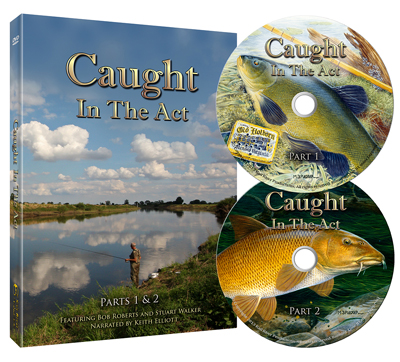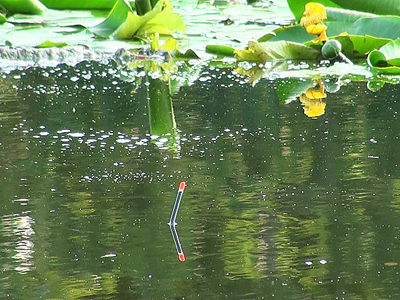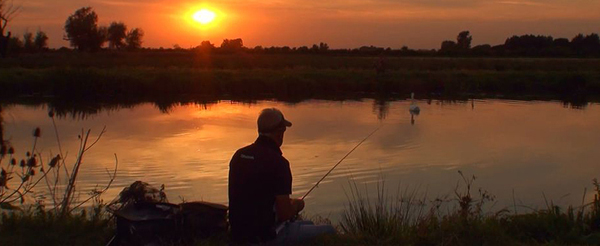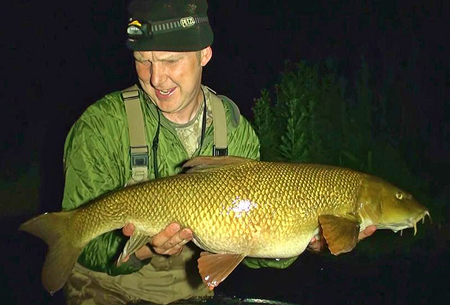‘Caught in the Act’ is the ambitious, latest project from Bob Roberts and Stuart Walker; the duo behind the successful and enlightening (it certainly taught me plenty about how barbel and rigs behave underwater) Barbel Days and Ways series, which features some terrific underwater footage. I am a fan of that series of DVDs and when I heard that this new series was in the making, which dramatically expanded the range of species targeted, I had high hopes for it.
The films are the result of over three years of angling trips to day ticket and open-access club waters, after a variety of species and over all four seasons. Each session is chronicled as a short ‘act’ and there are ten acts in this two DVD set, which covers spring and summer fishing (autumn and winter will follow later in the year as a separate double-disc set).
Stu and Bob don’t have the benefit of a professional cameraman on hand to film their sessions, but instead call upon their own filming experience from making Barbel Days and film one another. When one is fishing, the other does the filming and vice-versa. Both Bob and Stu are both accomplished anglers, which means when they effectively take on the roles of presenter, director, and producer, they have the perfect understanding of how to make a series that anglers will want to watch.
I can identify three key elements that make a successful angling programme – instruction, entertainment and atmosphere – and the audience for the programme can be dictated by how the programme makers choose to mix these ingredients.
 Programmes focusing mainly on technical elements are good for beginners and those looking to advance their own angling skills and whilst a little bit of fishing is often thrown in for good measure, to prove the theories work, an over-emphasis on the instruction and in-your-face product placement can make them heavy going for all but the keenest viewer.
Programmes focusing mainly on technical elements are good for beginners and those looking to advance their own angling skills and whilst a little bit of fishing is often thrown in for good measure, to prove the theories work, an over-emphasis on the instruction and in-your-face product placement can make them heavy going for all but the keenest viewer.
A few series have found mainstream TV success of late by being almost solely entertainment-driven; Robson Green landed on his feet there, but many anglers – including myself – cringe at his depiction of fishing. Whilst there is no doubt merit in finding ways to push angling as entertainment upon a TV audience who widely regard our sport as ‘boring’, such programmes offer little true satisfaction for the more serious angler.
Lastly, there are angling films which not only entertain and instruct, but attempt to convey the whole experience of a fishing trip, from the drama of a breaking dawn to the anticipation of a bite; the exhilaration of the battle to the quiet contemplation and reflection on the successes, failures and lessons of the day. ‘A Passion for Angling’ is the obvious example of a show which was as atmospheric as it was entertaining and it remains the high watermark in angling filmmaking to this day. Undoubtedly it is the programmes which best capture the atmosphere and experience of angling that set my needles flickering most, but it is rare that the filmmaker gets this final, most difficult element right. Having watched all ten acts, I can tell that in making CITA, this was something that Bob and Stu worked hard on getting right; and in my opinion they have succeeded.
 From the very moment you set eyes on the package the atmosphere is already building. The cover shot shows a solitary Bob Roberts trotting the tidal Trent; a tranquil scene that I would challenge any river angler to not wish to be a part of. Then, upon opening the case, one is confronted by two evocative, superbly detailed paintings of a recently landed tench and a barbel feeding in the flow. Press play and the atmosphere further builds with the epic, soaring classical title music which seems to audibly frame the stunning intro visuals perfectly. By this point I was already sucked in and couldn’t wait to see what came next.
From the very moment you set eyes on the package the atmosphere is already building. The cover shot shows a solitary Bob Roberts trotting the tidal Trent; a tranquil scene that I would challenge any river angler to not wish to be a part of. Then, upon opening the case, one is confronted by two evocative, superbly detailed paintings of a recently landed tench and a barbel feeding in the flow. Press play and the atmosphere further builds with the epic, soaring classical title music which seems to audibly frame the stunning intro visuals perfectly. By this point I was already sucked in and couldn’t wait to see what came next.
 A small but important part of setting the tone of an angling film is choosing the right narrator. In selecting Keith Elliott, Bob and Stu seem to have stumbled across a man born for the part. Keith’s voice is soft but evocative and he clearly lives and breathes angling and its history; as alluded to by his range of fishing-related quotes from diverse sources and by the brief glimpse we get of the inside of his delightfully chaotic study, with fishing books and memorabilia stacked high from every surface. I’d quite like to see more of Keith’s study, maybe as an extra on the next DVDs?
A small but important part of setting the tone of an angling film is choosing the right narrator. In selecting Keith Elliott, Bob and Stu seem to have stumbled across a man born for the part. Keith’s voice is soft but evocative and he clearly lives and breathes angling and its history; as alluded to by his range of fishing-related quotes from diverse sources and by the brief glimpse we get of the inside of his delightfully chaotic study, with fishing books and memorabilia stacked high from every surface. I’d quite like to see more of Keith’s study, maybe as an extra on the next DVDs?
With the scene set nicely by the packaging, the introduction and the narration, you’re into the first of the acts. I’ll describe each of them briefly so as not to put out too many ‘spoilers’ for anyone awaiting their copy.
In ‘Forgotten Paradise’ we join Stu raking a tench swim on an old, lily-filled estate lake and through a combination of impressive underwater footage and close-ups of bubbles rising all around his lift method float, by the time the bite came I was ready to strike myself!
 Next up is ‘Back to the Future’, where Bob has a hectic tench session, using more modern bolt-rig maggot feeder tactics on a gravel pit. At one point Bob has a double hook-up and has to hope that the second fish is still hooked by the time he’s landed the first.
Next up is ‘Back to the Future’, where Bob has a hectic tench session, using more modern bolt-rig maggot feeder tactics on a gravel pit. At one point Bob has a double hook-up and has to hope that the second fish is still hooked by the time he’s landed the first.
A change from stillwaters to the tidal Trent in ‘Going with the Flow’ sees Bob trotting this vast river for barbel, using an 11 foot power waggler rod. Bob’s insight stemming from a lifetime of trotting experience really brings this act to life. His advice on baiting techniques and rigs will surely make what many would see as a daunting way to fish for tidal river barbel seem achievable to most river anglers – and damn good fun to boot.

In the next, ‘Close Encounters’, the focus shifts towards carp as Stu stalks them at a local lake. After spotting a group of feeding fish the day before, Stu arrives to find they’ve moved on and has to think on his feet to stand any chance of hooking a fish. With no bite indication other than watching the rod move, this is great close-quarters footage. I took some amusement in watching a patriotic, bivvied-up angler on the far bank watching on with his morning brew, seemingly bewildered as Stu lands a fish in such a simple manner.

Bob travels to some fenland rivers for ‘Golden Delight’, in search of specimen rudd and my jaw dropped at some of the footage of the huge rudd in this act. Not only can they be seen freely taking maggots just in front of the underwater camera, but Bob gets them feeding so close-in and so close to the surface that in the crystal clear water that the fish can be seen clearly from above the surface too! Bob knows that after patiently feeding the rudd to get them this confident, he will only get one bite before the rest spook, but can he pick out one of the monsters? There’s also a nifty tip for loose-feeding bread around a float at distance later on in this act, which is worth looking out for.
‘Top Dog’ is another act featuring Bob, this time stalking summer carp on the surface, but a swan seems intent on spoiling the party. Again a pretty handy rig tip features, this time for a DIY controller which Bob puts to good use in landing a couple of stonking carp off the top.

Stu is in his absolute element during ‘In the Clear’, as he goes spotting barbel in a clear, low summer river. Once he locates a shoal of barbel and chub, he patiently entices them to feed and builds up their confidence for a good while before moving to the opposite bank to gently position his rig amongst the feeding fish. It is clearly inevitable that this methodical and painstaking approach will yield some fish in difficult conditions and Stu gets his just reward.
‘Driftbeater’ takes its name from the Drennan antenna float that Bob fishes for tench with in this act, at Bluebell Lakes. There are some incredible underwater shots of large tench on the feed, including a baited hook clearly falling right between the nose of a tench and the camera lens!
 The penultimate act, ‘Night Moves’, is the only sequence shot at night. Stu actively searches out some big barbel by feeding then resting several swims in rotation throughout the night. Filming in darkness presents its own problems and filming in the dark without spooking wary specimen fish must be close to impossible. However, by keeping the cameras rolling, the pair manage to capture the bite, the battle and the landing of a few fish, which is far more rewarding to the viewer than a gloomy, shaky shot as the cameraman rushes to start rolling after a fish has been hooked. This sequence is a highlight of the spring and summer acts for me, especially because Stu hooks a truly huge barbel and the whole thing is captured ‘from bite to bank’ on camera.
The penultimate act, ‘Night Moves’, is the only sequence shot at night. Stu actively searches out some big barbel by feeding then resting several swims in rotation throughout the night. Filming in darkness presents its own problems and filming in the dark without spooking wary specimen fish must be close to impossible. However, by keeping the cameras rolling, the pair manage to capture the bite, the battle and the landing of a few fish, which is far more rewarding to the viewer than a gloomy, shaky shot as the cameraman rushes to start rolling after a fish has been hooked. This sequence is a highlight of the spring and summer acts for me, especially because Stu hooks a truly huge barbel and the whole thing is captured ‘from bite to bank’ on camera.
In ‘Double Trouble’, the final act, we see both Stu and Bob on screen together, bream fishing alongside each other at Clumber Park. There’s no in-situ underwater footage in this act because they’re punching method feeders out at range, but that’s more than made up for by a string of fine bream that the pair bring to the bank, but will one of them be that magic double-figure slab they’re after?
Both anglers exude enthusiasm and confidence alongside a genuine belief and interest in what they’re doing whenever they are on screen. If you’re familiar with Bob’s online persona, you’ll know that he can be controversial, outspoken, even belligerent and bitter-sounding at times, but witness him in his ‘natural habitat’ by the waterside and he seems the polar opposite: authoritative and knowledgeable yes, but amiable, excitable and engaging along with it. The passion he has for fishing jumps out of the screen and at times you can almost watch his veins surge with blood and adrenaline as he sees a fish moving or spots a bite. There are times during the film where he has an almost child-like spring in his step and it is reassuring to see that angling can still bring such pleasure to a man who has fished as often and for as long as Bob has.
Although Stu is the less experienced presenter, again his passion is clear to see and the excitement and enthusiasm in his voice as he watches barbel feed or hooks a carp at close quarters makes you feel like you’re truly sharing the experience with him. Despite both anglers’ specimen hunting pedigree, when they each separately state that “it’s not about their size, it’s how you catch them”, you get the feeling that they mean every word.
All of the methods used in CITA are really simple. There are no fancy rigs or ‘You must use this specific tackle item or you won’t catch’ and the rigs that are used are well explained, with a few bonus tips as I mentioned earlier. The mixture of short but well-articulated rig and tackle talks in each act blend effortlessly into the film between scenic wide-angle shots, close-ups of the anglers in action and of course, the quality underwater footage.
It all seems very well judged and the quality of camera work belies the fact that only two of them – neither of whom is a professional cameraman – worked on the project. Occasionally a microphone gets blown in the wind or rubs against a coat and interferes with the sound quality, but this is a minor criticism of what is on the whole, a fine angling film.
Every single one of the acts made me want to go out and fish myself, which is surely the ultimate test of any fishing programme. I highly recommend that you watch CITA to judge for yourself, but I would rate it as one of the best fishing programmes I’ve watched since ‘A Passion’
You can watch a short trailer for ‘Caught in the Act’ below:













